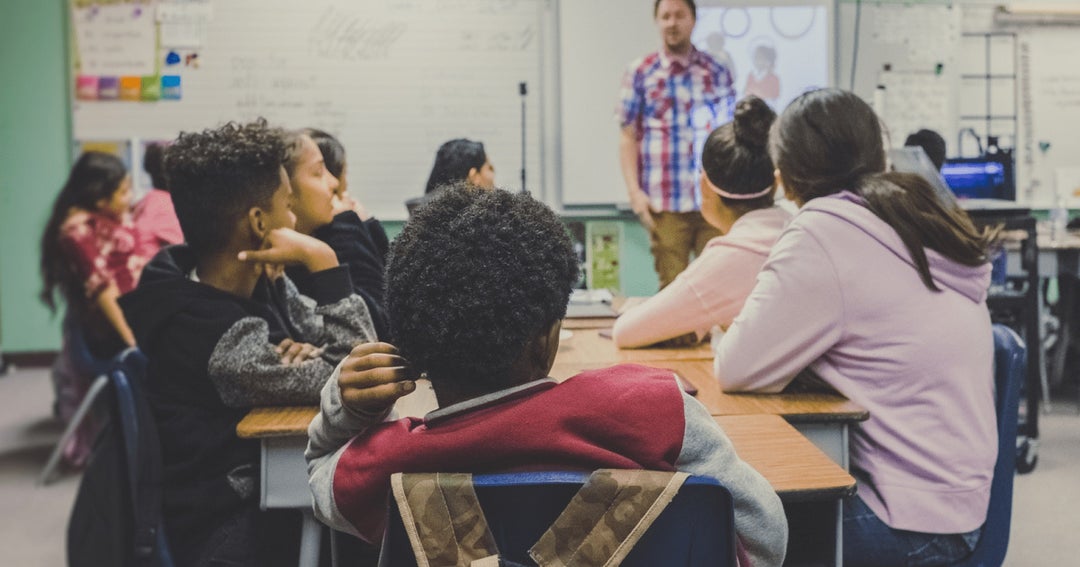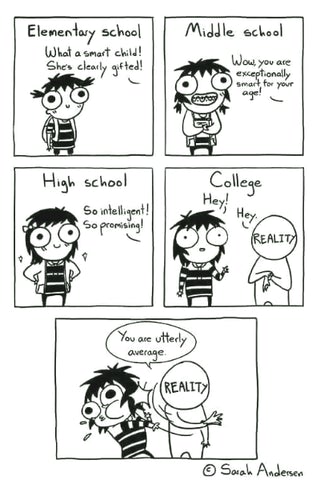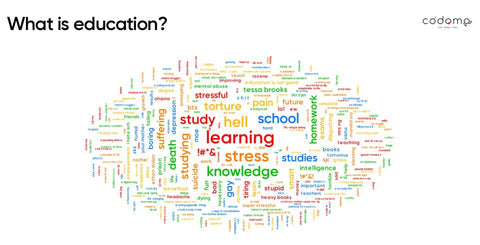

· By Codomo Singapore
Why Student-Centered Learning Matters And How To Apply It
Tips for how to have a more student-centered learning approach in class
"Schools kill creativity."
"I don't learn anything useful in school."
"Why do we need school when everything is already on the internet?"
"School does not prepare me for the future."
Any of these sound familiar? We have heard the rants about the current education system, such as questions about the real life application of knowing trigonometry or having to learn history when all the people are already dead.

Source: Sarah Andersen (Sarah's Scribbles) - Adulthood Is A Myth
I remember so many instances of myself in class just wondering, what exactly is the use of what I am learning? But what puzzled me the most was, why did I find school so boring? If I could spend hours just watching videos about random facts or reading a whole Wikipedia page on the origin of pyramids, it could not be that I hated learning. Many students complain about how they love to learn and gain knowledge but with little control over how they learn in school, they lose interest in what they are being taught.
Take this diagram showing what students think about when asked: "What is education?". The most common word used to describe it is 'learning' which is positive but the words that come after it, 'stress', 'hell', 'torture' and '!#*&', are rather negative. It seems quite obvious that these students do not enjoy school and this impacts the way they study as students who do not find school conducive will not be motivated to learn either.

In addition, students feel constantly pressurized because they have been fed this "if you do not get good grades, you will never get into a good college, then you cannot find a good job and will ultimately fail in life" narrative their entire childhood. Academics is just one small aspect of success, there is so much more to a person than their grades in school. Yet, even after knowing the tremendous amount of stress kids are under and how unhealthy it is for them, they are forced to perform.
We give children the opportunity to play, because when children are playing with something they get interested. And then you don’t have to teach, and you don’t have to police them either”
- Rob Houben
This approach for education was inspired by Frederick Taylor’s concept of scientific management. The current education system is hence not based on the individual but on the most efficient way to mass produce people for the workforce and help the economy. So, just based on the average student, we treat every child the same without considering their individual strengths because like a business, that would reduce waste of resources and increase efficiency.
Prior to this, children would educate themselves by exploring and through self-directed play. Children were driven to learn, it was not forced on them. Adults recognized that this was the natural way that children learnt so they allowed them the freedom to play and explore by themselves since it is human instinct to do so as a child. At this point, there was no contrast between what is play and what is work. Since we started to tell children that they need to completing school work before they can play, students associate school with work which in their books is something that is not fun but must be done.
Success back then was also not necessarily relative to how much money one had and a personalized education was not exclusive to the rich. Take Isaac Newton for example, a proficient physicist, mathematician, astronomer and alchemist born in 1643. During the plague in 1665, he had to leave Cambridge and go back home. Now, if I had to go back home for a while, I would probably be lazing around or resting. But not Newton. During his two year hiatus, he developed on his theories on calculus, optics and the law of gravitation. He even discovered the generalized binomial theorem and started to come up with a mathematical theory that later became infinitesimal calculus.
That just goes to show how far a self-motivated individual can go. There is no need for expensive tutors, but just the innate desire to learn we all have. Newton was always curious and had he not explored theories on his own, he would probably not have accomplished all that he has.
The industrial revolution saw a different model for education. Since the main focus at that point was to get more people working in places like factories, schools would feed students information and told not to question as that was the way to prepare them for the workforce during the second industrial revolution. It was like a factory line, manufacturing "perfect students" to go into the workforce and maximize efficiency.
What Is Student-Centered Learning
Our time is different from back then. Our society has evolved and we do not have to be compartmentalized workers for factories any longer. Instead, our society needs more innovative problem solvers right now. The framework used for education during industrialization might not be the best approach to education today.
Another Brick In The Wall - Pink Floyd
The opposite of the one size fits all curriculum, is student-centered learning. According to Education Evolving, there are seven principles that make up the foundation of student-centered learning.

Seven principles of student-centered learning
These principles focus on having kids shape their learning experience and involving them in decision-making. They are allowed to have a voice in what they learn and how they learn it while understanding the value of it. It can be hard to want to keep learning when the relevance of what is being taught is unclear. It is much easier to do something and stay motivated to finish it when it has a purpose. By giving students a picture of what they are working towards, they will be more focused and driven to work towards the goal, whether it is academics related or not.
It is also crucial to let students decide what they want to focus on. This does not mean that they drop subjects that they are not interested in because if done properly, interest in those subjects could be built. Students should be allowed to decide the focus of the content being taught. Classrooms that practice student-centered learning have this in common. Teachers would ask their students to research and write about something they like. By aligning students' interests with the lesson objectives, teachers are able to get them excited about the subject. This makes classes much more engaged than a structured and inflexible curriculum.
We also know that students have different paces of learning. Some are fast-learners while some take time to process what is being taught. Schools have tried to fix this issue by separating their students based on their speed of learning but the more challenging issue is that students also learn differently. I personally learn best with visuals. Having a physical representation or depiction of what I am learning makes it much easier for me to make connections and to understand concepts. You probably also have a preferred way of learning, whether it is aural, visual, kinesthetic, etc. To fix this problem, students should be allowed to pick how they are taught. Even something as simple as asking students for a few ideas on how a topic should be taught, and then picking what the majority votes for, can help.

The Different Characteristics of Student-Centered Learning
Evidence That It Works
The biggest question that comes after understanding what student-centered learning is, does it even work?
The idea of letting kids be independent, be a part of decision making and choose the path for learning sounds great on paper but it also sounds like a huge risk. Proof that this way of teaching actually works would be very reassuring won't it? Lucky for you, there are loads of people that have tried implementing this in classrooms.
Take this study for example. In 2015, the Nellie Mae Education Foundation and UMass Donahue Institute published the results of using a student-centered learning approach in 12 public high schools in New England. They identified student-centered learning as something with the following characteristics:
- Learning is Personalized
- Learning is Competency Based
- Learning Takes Place Anytime, Anywhere
- Students Take Ownership
Most of the high schools were able to meet this characteristics but there were many problems with the "anytime, anywhere" experiences, such as issues with budget, transport and partnerships. On the more positive side, teachers responded to student-centered learning as something that helped make their students participate more and the lessons were a lot more fruitful. Also, the students could understand and remember what they were learning a lot better than when they were in a conventional classroom setting.
Another example showing the benefits of student-centered learning is the Agora school in Roermond, managed by Rob Houben in the Netherlands. In an interview with pi-top, he explained the reasons why the school had no timetables and why the kids were given so much freedom in their learning.
The design and intention of our country’s public education system was never to educate nor meet the needs of all students. Rather, its purpose was to prepare students, in mass, to work in an industrialized and standardized economy.
- Education Evolving
The way the school runs is rather interesting because firstly, there are no year groups, everyone can choose what they want to learn based on what interests them. Each teacher also focuses on just 17 students instead of the conventional large classes of 30. Students also are given a chance to make their own desks which would have been great when I was in school because I could never for the life of me fit everything on those tiny desks. This small task allowed for students to not just be creative and learn how to design, it also taught them certain concepts such as how to calculate the volume of a cuboid so that they could fit their desks on the lift.
This is mainly how they pick up concepts. Instead of being taught, they learn it through trying to solve problems and this is a great way to show students that what they are learning has real-world applications. Another thing they do differently is that they allow students to use their phones and computers at any time. It sounds like a terrible idea because there is no guarantee that the kids would not use them the whole day. But the idea is kind of genius.
It is sort of similar to how medicine builds our body's immunity to certain viruses by actually injecting those viruses into our body. By allowing students to use their phones or laptops, it enables them to practice more self-control, as compared to just locking them away which only makes the kids want to use them even more.
As for tracking their progress, three Agora students designed a software called Egodact which is a way for students to do just that. The three of them have also set up a company to make this software available for more changemaker schools, which is very impressive considering they started this at just 14!
It's not just Agora that has tried student-centered learning. Bill Nave is the author of the book "Student-centered Learning: Nine Classrooms in Action" in which nine award-winning K–12 teachers talk about their journey with student-centered learning. Nave said something in a podcast on Harvard EdCast that really resonated with me. He asked listeners to think back to when they were in school and to remember one or two really good teachers. He then asked, what made the top teacher in that list a good teacher? The reason why I found this question so intriguing was because I realized that my answers were very much aligned with what student-centered learning is about.
The top teacher on my list was my favorite because of the way he taught. Not just because he helped my grades jump from constantly failing to getting an A, but he really listened to what each of his students were struggling with. Every time that we got our test results back, he would ask us what we think we should do to improve and he would pull us aside one by one to ask each of us what we were struggling with. Some of us were not even sure what we were having troubles with but he would help us figure out exactly what our weak points were. Each time he would try different teaching methods with the class, and see which engaged us the most.
With all the time he dedicated to getting to know all of us and finding out what works for us, he was able to not just pull all of our grades up but also create a bond with everyone. Because of this bond, we were more focused and prepared for his lessons. I know it sounds like I am making this up, but my lessons with this teacher were really as amazing as they sound. He had been practicing student-centered learning the whole time and had it not been for Bill Nave's question, I would have never realized the positive impact student-centered learning has had on me.
Now if I were to reverse the question and ask you who was your least favorite teacher, what would be your reason for picking them? Most people would mention the teacher being too strict and not really caring about each student.
If you are an educator and think that student-centered learning is just what your class needs, here are some tips.
Tips For Student-Centered Learning
There are many ways that it can be made part of the curriculum and you may be surprised to hear that games are also a possible solution.
Projects

Project-based learning is a great way to get students involved in what they are learning. By giving students a project to work on, not only does it make them more engaged in what they are being taught but it also teaches a lot of important life skills.
It makes them develop responsibility, initiative, resilience, teamwork and a growth mindset as there is emphasis on the application of the 21st century skills - critical thinking, communication, collaboration and creativity. Projects can be demanding and students learn how to work with different people while also understanding how to bring together what they have learnt from different subjects. Hence, overall they get a much deeper understanding of the topic they are exploring.
Student Decision

Students can have some opinions on what they are learning and even though it might be tempting to just tell them that it is all important, it is useful for us to listen to what they have to say. Students learn best in a comfortable environment and this can be influenced by what they think about the things being taught as well. In order for students to enjoy lessons and be interested in what they are learning, they need to understand why they are being taught those topics in the first place. So take some time to explain the reason why they are learning those topics by relating it to their life and how its real-life application impacts them.
Let them decide where the lessons are headed. They might have some ideas on how lessons can be carried out. For example, for a mathematics lesson, they might suggest having groups present solutions to different questions.
One of the best ways to tailor the lesson to students’ interest is by asking them.
Here’s an idea-instead of approaching students directly for suggestions (which can be a little bit intimidating for the shyer students), you can use Rolljak to gather feedback. Create a game session and ask them about what they would like to see incorporated into their lessons. The use of a game to gather feedback helps to put them at ease, and ensures that every student’s opinion is conveyed!
By listening to how the students want to learn, it will make them a lot more invested in the lesson. We too, applied this concept in the development of our Potato Pirates board game.
Our game series- Potato Pirates, which introduces computer science concepts to players through games, was conceptualised using the student-centred approach. We heard students out- coding seems intimidating, and the concepts can be difficult to get. Learning coding the traditional way is too tedious for many young students to focus well- and students get frustrated with the endless slew of errors that pop up when first starting out. All these factors lead to a loss of motivation to learn, and we decided to task ourselves with the challenge of combating these factors. The popularity of our game is a testament to the fact that we listened, and addressed theses students’ pains.
Chance To Lead

Leadership is a very useful skill to have. It has some distinct qualities such as confidence, integrity, communication, work ethic, accountability and empathy. These are all very applicable skills to have throughout life and hence developing these skills from a young age is great.
Allowing students to take on bigger responsibilities such as being in charge of student organized events or leading a classroom will allow them to practice leadership. In order to give everyone an equal opportunity, leadership roles can also be rotated every now and then so that all students have an equal chance at practicing the skill.
Help Students Understanderstand Weak Points

As much as we would like to quickly move on to the next topic in class, some students might be struggling. By helping them understand those areas, they will be able to keep up with the class. Hence, it is important to give each student attention and help each of them individually.
Guide them through what they do not understand and when they are unable to identify where they can improve, help them see those areas. By doing this, students will also put more trust in their teachers and be more willing to ask questions. A lot of students feel scared to clarify doubts or ask their teachers questions but by helping them individually, they would not feel as scared.
Experiment With Different Teaching Methods

Teaching students by simply feeding them content is not an effective way of teaching. Students will be bored and not really engaged. To solve this issue, lessons can be more unconventional. Some ways that lessons can be made a lot more engaging are through games, group work, projects and presentations.
There are some great games that are made to teach kids certain skills or educate them on certain topics. But you do not have to buy any games, there are equally as effective ways to play yet learn through activities.
For example, you can use the free online educational game Rolljak, which features many customisable templates to suit your teaching needs, from teaching new items, to reviewing concepts. Rolljak’s design allows for collaborative learning among players, fuelling students’ competitive spirit. This makes the lessons being taught very fun and students will be able to retain what has been taught much better.
Don’t worry if you can’t implement all of these at once-take it one step and a time. Most importantly, continue to value each of your student in your shared pursuit in maximising their learning. Your students will definitely appreciate you!
Oh, before you go, I just want to mention our latest coding card game, Potato Pirates 3: Battlechips. It might be a perfect classroom activity if you want to introduce computer science to your students because playing games is way more fun than reading a textbook, don’t you agree?
For ideas on activities that can help you get started with the student-centered approach, drop in your email and we will share some resources with you.
Share:
1 comment
-
The 7 principles of student-cenetered learnig really useful for my TnL for tertiary level education.Tq
baskaran on


